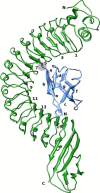Of mice and men: Dissecting the interaction between Listeria monocytogenes Internalin A and E-cadherin
- PMID: 24688730
- PMCID: PMC3962206
- DOI: 10.5936/csbj.201303022
Of mice and men: Dissecting the interaction between Listeria monocytogenes Internalin A and E-cadherin
Abstract
We report a study of the interaction between internalin A (inlA) and human or murine E-cadherin (Ecad). inlA is used by Listeria monocytogenes to internalize itself into host cell, but the bacterium is unable to invade murine cells, which has been attributed to the difference in sequence between hEcad and mEcad. Using molecular dynamics simulations, MM/GBSA free energy calculations, hydrogen bond analysis, water characterization and umbrella sampling, we provide a complete atomistic picture of the binding between inlA and Ecad. We dissect key residues in the protein-protein interface and analyze the energetics using MM/GBSA. From this analysis it is clear that the binding of inlA-mEcad is weaker than inlA-hEcad, on par with the experimentally observed inability of inlA to bind to mEcad. However, extended MD simulations of 200 ns in length show no destabilization of the inlA-mEcad complex and the estimation of the potential of mean force (PMF) using umbrella sampling corroborates this conclusion. The binding strength computed from the PMFs show no significant difference between the two protein complexes. Hence, our study suggests that the inability of L. monocytogenes to invade murine cells cannot be explained by processes at the nanosecond to sub-microsecond time scale probed by the simulations performed here.
Keywords: E-cadherin; Internalin A; energy decomposition; molecular dynamics; umbrella sampling.
Figures








Similar articles
-
Murinization of internalin extends its receptor repertoire, altering Listeria monocytogenes cell tropism and host responses.PLoS Pathog. 2013;9(5):e1003381. doi: 10.1371/journal.ppat.1003381. Epub 2013 May 30. PLoS Pathog. 2013. PMID: 23737746 Free PMC article.
-
Anti-InlA single-domain antibodies that inhibit the cell invasion of Listeria monocytogenes.J Biol Chem. 2023 Oct;299(10):105254. doi: 10.1016/j.jbc.2023.105254. Epub 2023 Sep 14. J Biol Chem. 2023. PMID: 37716701 Free PMC article.
-
Directed evolution and targeted mutagenesis to murinize Listeria monocytogenes internalin A for enhanced infectivity in the murine oral infection model.BMC Microbiol. 2010 Dec 13;10:318. doi: 10.1186/1471-2180-10-318. BMC Microbiol. 2010. PMID: 21144051 Free PMC article.
-
Listeria monocytogenes internalin and E-cadherin: from bench to bedside.Cold Spring Harb Perspect Biol. 2009 Oct;1(4):a003087. doi: 10.1101/cshperspect.a003087. Cold Spring Harb Perspect Biol. 2009. PMID: 20066101 Free PMC article. Review.
-
Listeria monocytogenes internalin and E-cadherin: from structure to pathogenesis.Cell Microbiol. 2009 May;11(5):693-702. doi: 10.1111/j.1462-5822.2009.01293.x. Epub 2009 Feb 2. Cell Microbiol. 2009. PMID: 19191787 Review.
Cited by
-
Modeling the Anti-Adhesive Role of Punicalagin Against Listeria Monocytogenes from the Analysis of the Interaction Between Internalin A and E-Cadherin.Int J Mol Sci. 2025 Jul 29;26(15):7327. doi: 10.3390/ijms26157327. Int J Mol Sci. 2025. PMID: 40806459 Free PMC article.
-
A Structural Study on the Listeria Monocytogenes Internalin A-Human E-cadherin Interaction: A Molecular Tool to Investigate the Effects of Missense Mutations.Toxins (Basel). 2020 Jan 20;12(1):60. doi: 10.3390/toxins12010060. Toxins (Basel). 2020. PMID: 31968631 Free PMC article.
References
-
- Hamon M, Bierne H, Cossart P (2006) Listeria monocytogenes: a multifaceted model. Nat rev Microbiol 4: 423–434 - PubMed
-
- Bierne H, Sabet C, Personnic N, Cossart P (2007) Internalins: a complex family of leucine-rich repeat-containing proteins in Listeria monocytogenes. Microbes Infect 9: 1156–1166 - PubMed
LinkOut - more resources
Full Text Sources
Other Literature Sources
Miscellaneous
